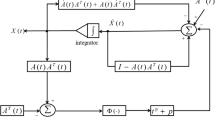Abstract
In this paper, finite-time Zhang neural networks (ZNNs) are designed to solve time-varying quadratic program (QP) problems and applied to robot tracking. Firstly, finite-time criteria and upper bounds of the convergent time are reviewed. Secondly, finite-time ZNNs with two tunable activation functions are proposed and applied to solve the time-varying QP problems. Finite-time convergent theorems of the proposed neural networks are presented and proved. The upper bounds of the convergent time are estimated less conservatively. The proposed neural networks also have superior robustness performance against perturbation with large implementation errors. Thirdly, feasibility and superiority of our method are shown by numerical simulations. At last, the proposed neural networks are applied to robot tracking. Simulation results also show the effectiveness of the proposed methods.












Similar content being viewed by others
References
Li S, Liu B, Li Y (2013) Selective positive–negative feedback produces the winner-take-all competition in recurrent neural networks. IEEE Trans Neural Netw Learn Syst 24(2):301–309
Liu Q, Wang J (2008) Two k-winners-take-all networks with discontinuous activation functions. Neural Netw 21(2–3):406–413
Hu X, Zhang B (2009) A new recurrent neural network for solving convex quadratic programming problems with an application to the k-winners-take-all problem. IEEE Trans Neural Netw 20(4):654–664
Tymoshchuk P (2013) A model of analogue k-winners-take-all neural circuit. Neural Netw 42:44–61
Johansen TA, Fossen TI, Berge SP (2004) Constrained nonlinear control allocation with singularity avoidance using sequential quadratic programming. IEEE Trans Control Syst Technol 12:211–216
Fares B, Noll D, Apkarian P (2002) Robust control via sequential semidefinite programming. SIAM J Control Optim 40:1791–1820
Leithead WE, Zhang Y (2007) O(\(N^2\))-operation approximation of covariance matrix inverse in Gaussian process regression based on quasi-Newton BFGS method. Commun Stat Simul Comput 36:367–380
Yang Y, Zhang Y (2013) Superior robustness of power-sum activation functions in Zhang neural networks for time-varying quadratic programs perturbed with large implementation errors. Neural Comput Appl 22:175–185
Wang J, Zhang Y (2004) Recurrent neural networks for real-time computation of inverse kinematics of redundant manipulators. Machine intelligence quo vadis?. World Scientific, Singapore
Zhang Y, Tan Z, Chen K, Yang Z, Lv X (2009) Repetitive motion of redundant robots planned by three kinds of recurrent neural networks and illustrated with a four-link planar manipulator’s straight-line example. Robot Auton Syst 57:645–651
Zhang Y, Ma W, Li X, Tan H, Chen K (2009) MATLAB Simulink modeling and simulation of LVI-based primal-dual neural network for solving linear and quadratic programs. Neurocomputing 72:1679–1687
Zhang Y, Tan Z, Yang Z, Lv X (2008) A dual neural network applied to drift-free resolution of five-link planar robot arm. In: Proceedings of the 2008 IEEE international conference on information and automation. Zhangjiajie, China, 20–23 June 2008
Boggs PT, Tolle JW (1995) Sequential quadratic programming. Acta Numer 4:1–51
Murray W (1997) Sequential quadratic programming methods for large-scale problems. Comput Optim Appl 7:127–142
Hu J, Wu Z, McCann H, Davis LE, Xie C (2005) Sequential quadratic programming method for solution of electromagnetic inverse problems. IEEE Trans Antennas Propag 53:2680–2687
Zhang Y, Ma W, Cai B (2009) From Zhang neural network to Newton iteration for matrix inversion. IEEE Trans Circuits Syst I 56(7):1405–1415
Zhang Y, Ge SS (2005) Design and analysis of a general recurrent neural network model for time-varying matrix inversion. IEEE Trans Neural Netw 16(6):1477–1490
Zhang Y, Jiang D, Wang J (2002) A recurrent neural network for solving Sylvester equation with time-varying coefficients. IEEE Trans Neural Netw 13(5):1053–1063
Li Z, Zhang Y (2010) Improved Zhang neural network model and its solution of time-varying generalized linear matrix equations. Expert Syst Appl 37(10):7213–7218
Zhang Y, Li Z (2009) Zhang neural network for online solution of time-varying convex quadratic program subject to time-varying linear-equality constraints. Phys Lett A 373:1639–1643
Li S, Li Y, Wang Z (2013) A class of finite-time dual neural networks for solving quadratic programming problems and its k-winners-take-all application. Neural Netw 39:27–39
Li S, Chen S, Liu B (2013) Accelerating a recurrent neural network to finite-time convergence for solving time-varying Sylvester equation by using a sign-bi-power activation function. Neural Process Lett 37:189–205
Miao P, Shen Y, Xia X (2014) Finite time dual neural networks with a tunable activation function for solving quadratic programming problems and its application. Neurocomputing 143:80–89
Shen Y, Xia X (2008) Semi-global finite-time observers for nonlinear systems. Automatica 44:3152–3156
Shen Y, Huang Y (2012) Global finite-time stabilisation for a class of nonlinear systems. Int J Syst Sci 43(1):73–78
Miao P, Shen Y, Hou J, Shen Y (2014) A recurrent neural network with a tunable activation function for solving k-winners-take-all. In: Proceedings of the 33rd Chinese control conference July 28–30. Nanjing, China, pp 4957–4962
Bhat S, Bernstein D (2000) Finite-time stability of continuous autonomous systems. SIAM J Control Optim 38:751–766
Kumar Naveen, Panwar Vikas, Borm Jin-Hwan, Chai Jangbom, Yoon Jungwon (2013) Adaptive neural controller for space robot system with an attitude controlled base. Neural Comput Appl 23:2333–2340
Li S, Cui H, Li Y, Liu B, Lou Y (2013) Decentralized control of collaborative redundant manipulators with partial command coverage via locally connected recurrent neural networks. Neural Comput Appl 23:1051–1060
Torres C, de Jesús Rubio J, Aguilar-Ibáñez CF, Pérez-Cruz JH (2014) Stable optimal control applied to a cylindrical robotic arm. Neural Comput Appl 24:937–944
Samy Assal FM (2013) Learning from hint for the conservative motion of the constrained industrial redundant manipulators. Neural Comput Appl 23:1649–1660
Acknowledgments
This work was supported by the National Science Foundation of China (Nos. 61374028, 61374171, 51177088, 61273183, 61304162), the Grant National Science Foundation of Hubei Provincial (2013CFA050), and the Graduate Scientific Research Foundation of China Three Gorges University (2014PY064, 2014PY069).
Author information
Authors and Affiliations
Corresponding author
Rights and permissions
About this article
Cite this article
Miao, P., Shen, Y., Huang, Y. et al. Solving time-varying quadratic programs based on finite-time Zhang neural networks and their application to robot tracking. Neural Comput & Applic 26, 693–703 (2015). https://doi.org/10.1007/s00521-014-1744-4
Received:
Accepted:
Published:
Issue Date:
DOI: https://doi.org/10.1007/s00521-014-1744-4




